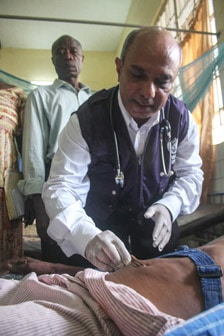
Vibrio cholerae infection

Cholera, caused by the bacteria Vibrio cholerae, is rare in the United States and other industrialized nations. However, globally, cholera cases have increased steadily since 2005 and the disease still occurs in many places including Africa, Southeast Asia, and Haiti. CDC responds to cholera outbreaks across the world using its Global Water, Sanitation and Hygiene (WASH) expertise.
Illness & Symptoms
Cholera is an acute, diarrheal illness caused by infection of the intestine with the bacterium Vibrio cholerae and is spread by ingestion of contaminated food or water. The infection is often mild or without symptoms, but sometimes it can be severe and life threatening.

A physician checking a patient for dehydration
Approximately one in ten (5-10%) of infected persons will have severe cholera which in the early stages includes:
- profuse watery diarrhea, sometimes described as “rice-water stools,”
- vomiting
- rapid heart rate
- loss of skin elasticity
- dry mucous membranes
- low blood pressure
- thirst
- muscle cramps
- restlessness or irritability
Persons with severe cholera can develop acute renal failure, severe electrolyte imbalances and coma. If untreated, severe dehydration can rapidly lead to shock and death in hours.
Profuse diarrhea produced by cholera patients contains large amounts of infectious Vibrio cholerae bacteria that can infect others if ingested, and when these bacteria contaminate water or food will lead to additional infections. Dispose of human waste appropriately to prevent the spread of cholera.